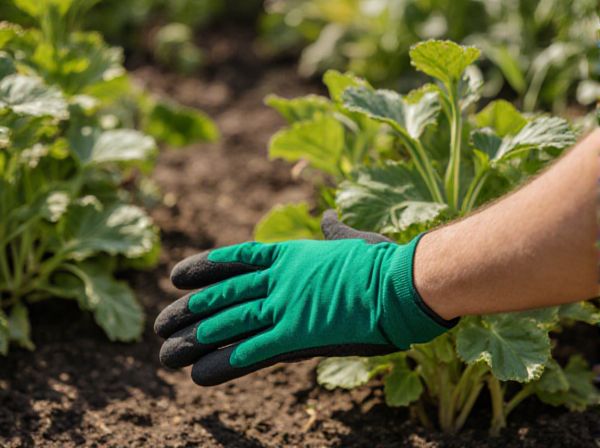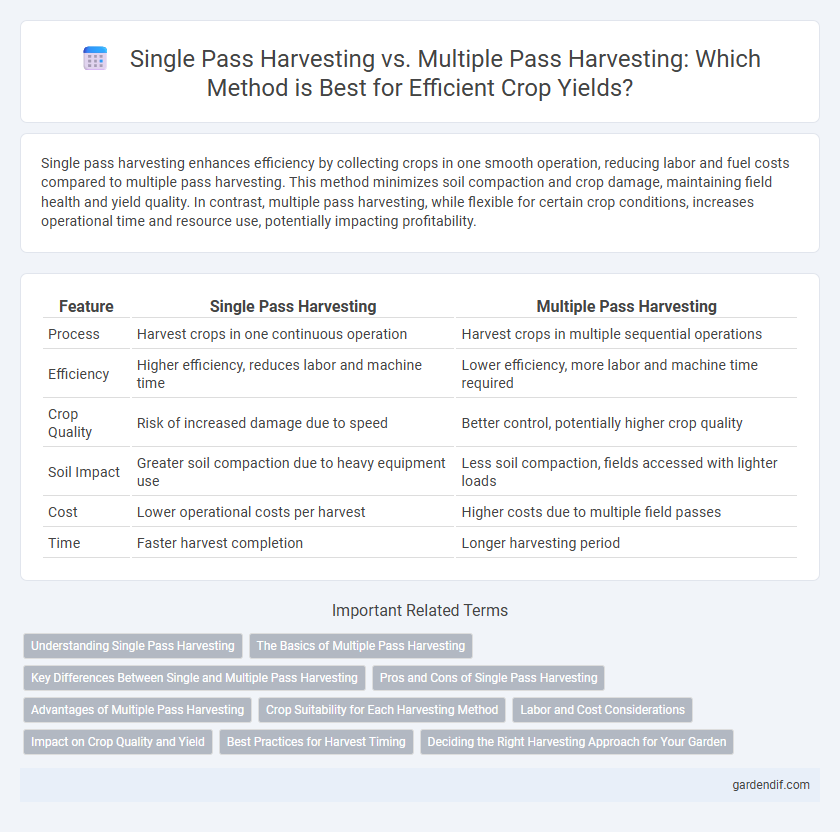
Single Pass Harvesting vs Multiple Pass Harvesting Illustration
Single pass harvesting enhances efficiency by collecting crops in one smooth operation, reducing labor and fuel costs compared to multiple pass harvesting. This method minimizes soil compaction and crop damage, maintaining field health and yield quality. In contrast, multiple pass harvesting, while flexible for certain crop conditions, increases operational time and resource use, potentially impacting profitability.
Table of Comparison
| Feature | Single Pass Harvesting | Multiple Pass Harvesting |
|---|---|---|
| Process | Harvest crops in one continuous operation | Harvest crops in multiple sequential operations |
| Efficiency | Higher efficiency, reduces labor and machine time | Lower efficiency, more labor and machine time required |
| Crop Quality | Risk of increased damage due to speed | Better control, potentially higher crop quality |
| Soil Impact | Greater soil compaction due to heavy equipment use | Less soil compaction, fields accessed with lighter loads |
| Cost | Lower operational costs per harvest | Higher costs due to multiple field passes |
| Time | Faster harvest completion | Longer harvesting period |
Understanding Single Pass Harvesting
Single pass harvesting involves collecting crops in one continuous operation, significantly reducing time and fuel consumption compared to multiple pass harvesting. This method minimizes soil compaction and crop damage, promoting better yield quality and operational efficiency. Advanced machinery with integrated functions enables seamless cutting, threshing, and separation during the single pass process.
The Basics of Multiple Pass Harvesting
Multiple pass harvesting involves cutting crops in several stages, allowing for selective removal based on crop ripeness or field conditions. This method enhances overall yield quality by enabling farmers to target prime harvest windows for different sections of a field. It requires more time and labor but offers flexibility and can reduce losses from weather damage or uneven crop maturity.
Key Differences Between Single and Multiple Pass Harvesting
Single pass harvesting completes cutting, threshing, and cleaning in one operation, significantly reducing time and labor costs. Multiple pass harvesting divides the process into stages, allowing for greater control over grain quality and moisture content but requires more equipment and manpower. Single pass systems optimize efficiency in large-scale farming, while multiple pass harvesting suits smaller farms prioritizing product preservation and processing flexibility.
Pros and Cons of Single Pass Harvesting
Single pass harvesting offers significant efficiency by completing cutting, threshing, and cleaning operations in one continuous motion, reducing labor and fuel costs. However, the method can lead to lower grain quality and higher moisture content due to less precise separation compared to multiple pass harvesting. Equipment wear and maintenance can also be more intensive since all harvesting functions are performed simultaneously.
Advantages of Multiple Pass Harvesting
Multiple pass harvesting allows for more precise crop management, reducing soil compaction and preserving soil health by spreading field traffic over multiple days. It enhances harvesting flexibility by enabling better timing adjustments to match crop maturity and weather conditions, ultimately improving yield quality. This method also facilitates thorough residue management, supporting sustainable farming practices and promoting long-term productivity.
Crop Suitability for Each Harvesting Method
Single pass harvesting is ideal for crops like soybeans and small grains that mature uniformly, ensuring maximum efficiency and minimal crop loss. Multiple pass harvesting suits crops such as corn and cotton, where staggered maturity or varying field conditions require selective harvesting to optimize yield and quality. Choosing the appropriate method depends on crop type, growth patterns, and environmental factors to enhance productivity.
Labor and Cost Considerations
Single pass harvesting significantly reduces labor requirements by combining cutting, threshing, and cleaning into one operation, which lowers overall labor costs and increases efficiency. Multiple pass harvesting demands more labor due to separate operations for cutting, threshing, and hauling, leading to higher wages and extended machine usage. Cost considerations favor single pass harvesting in large-scale farming as it minimizes fuel consumption and equipment wear, optimizing operational expenses.
Impact on Crop Quality and Yield
Single pass harvesting minimizes crop exposure to environmental stress, preserving grain moisture and reducing kernel damage, which enhances overall crop quality and yield consistency. Multiple pass harvesting can increase field traffic, leading to soil compaction and uneven crop maturity, potentially lowering grain quality and increasing losses. Optimizing harvest timing with single pass methods ensures maximum nutrient retention and optimal market value.
Best Practices for Harvest Timing
Single pass harvesting maximizes efficiency by cutting and collecting crops in one continuous operation, reducing grain loss and exposure to adverse weather conditions. Multiple pass harvesting allows for more precise timing by separating cutting and collection, which can help optimize moisture levels and reduce grain damage under variable field conditions. Best practices for harvest timing emphasize monitoring crop maturity through moisture content and weather forecasts to determine the optimal balance between yield quality and operational efficiency.
Deciding the Right Harvesting Approach for Your Garden
Single pass harvesting maximizes efficiency by collecting mature crops in one go, ideal for gardens with uniform crop maturity and limited labor. Multiple pass harvesting allows selective picking at peak ripeness, enhancing quality and reducing waste but requiring more time and effort. Evaluate crop type, garden size, labor availability, and desired produce quality to determine the most suitable harvesting method for your garden.
Single Pass Harvesting vs Multiple Pass Harvesting Infographic

 gardendif.com
gardendif.com